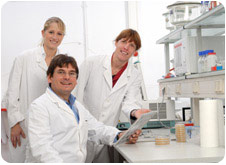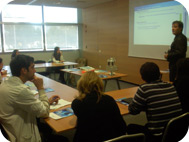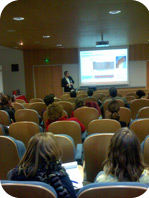LabCluster
Tour GRAND OUEST- Brest
|
|
La participation est gratuite sur inscription Il est possible de s'inscrire à la totalité de la journée ou seulement à une ou plusieurs conférences. |
|||||
| Cliquez ici pour vous inscrire |
|
||||
| Single
cell, transcriptomique, protéomique, analyse de data |
||||||
Programme :
| |
Accueil café et viennoiseries dès 9H30 10H00- 10H30 Présentation des plateformes omics du territoire - axe bioimagerie Pierre-Antoine Eliat (Biogenouest) 10H30-11H05 HYPERION™ (Standard Biotools) / Patrice Hemon, Plateforme HYPERION - UBO Mélanome en Bretagne : Mythe ou réalité ? Exploration du microenvironnement tumoral par imagerie de masse Voici Hyperion™ XTi, un système révolutionnaire de cytométrie de masse par imagerie. Détection 5 fois plus rapide, sensibilité inégalée pour les marqueurs faibles, cytométrie en flux autonome, et nouveaux modes d'imagerie. Imagerie ultra-rapide de l'ensemble des lames et sélection intelligente des ROI redéfinissent la cytométrie à haut débit. 11H05-11H40 XENIUM (10X Genomics) / Henri-Alexandre Michaud, Plateforme SimCaT - IRCM de Montpellier When spatial transcriptomics met imaging mass cytometry: a big data love story Découvrez Xenium In Situ, une solution de profilage spatial subcellulaire à haute performance qui simplifie la cartographie avancée de l’ARN. En permettant l’analyse à haut débit de milliers de cibles d’ARN dans leur contexte tissulaire natif, la plateforme Xenium offre des informations inédites sur la structure et la fonction cellulaires. Le système intégré comprend un instrument polyvalent et convivial, une chimie sensible et spécifique, ainsi qu’un logiciel de visualisation performant—autant d’éléments qui permettent aux chercheurs d’explorer de nouvelles dimensions dans la découverte biologique. 11H40 - 12H15 RHAPSODY™ (BD Biosciences) / Aymeric Silvin, UMR 1015 Gustave Roussy/Inserm/Université Paris-Saclay High throughput sc RNA seq as a tool for better understanding ofimmune cell heterogeneity and their contribution to diseases Your trusted partner in flow cytometry, BD Biosciences now provides high-quality scM instruments, reagents and bioinformatics tools that provide reliable, reproducible single-cell multiomics data necessary for use in translational research settings. With our microwell-based scM instruments, you can now obtain more proteomics and genomics data. 12H30-14H00 COCKTAIL DEJEUNATOIRE 14H00 - 14H35 Logiciel PHENOPLEX (Visiopharm) / Soizic Garaud, LBAI - UBO Application of Phenoplex Workflow in Analyzing the Tissue Microenvironment in Immunotherapy-Related Toxicities Using High-Plex Immunofluorescence Spatial biology is revolutionizing molecular biology by enabling the examination of cells within their tissue microenvironment. It empowers scientists to reconstruct tissue structures and compartments and investigate intricate cell-to-cell interactions and dependencies. The resulting multiplexed images require easy-to-use image analysis tools that are tailored specifically for biologists and pathologists. Emphasizing the practical needs of biologists and pathologists, we will delve into Phenotyping for characterizing cellular populations and discerning pathological features as well as spatial neighborhood analysis tools, illuminating the spatial relationships vital for understanding microenvironmental influences. AKOYA BIOSCIENCES Single-Cell Spatial Phenotyping: Setting the pace of Discovery and Translational Research 14h35-15h10 ORION™ (Rarecyte) / Léa Guyonnet, Plateforme CYTPIC - Institut Curie, Paris Key player in our integrated single-cell multiomic spatial pipeline The Orion next generation imaging platform represents a paradigm shift for spatial biology by enabling single-round high-plex staining and imaging of specimens mounted on standard glass microscope slides. The single-round workflow provides numerous advantages, including ultra-high sample throughput with low running costs to enable multiple studies per week and large cohort studies, while preserving tissue for pristine data quality. The presentation will review the Orion technology, workflow, reagents, and panel design, and will review recent data published by Orion customers along with several example datasets. 15h10-15h45 CosMX (Bruker Spatial Biology) / Anthony Sébillot - Plateforme H2P2, Biosit, Université de Rennes Utilisation de la transcriptomique spatiale et de l'onco-immunoprotéomique pour étudier le cancer du foie Bruker Spatial Biology, a division of Bruker Corporation,provides advanced spatial molecular biology solutions,including instruments, assays, software, and services to support life sciences research.By integrating technologies from NanoString and CanopyBiosciences, Bruker offers an extensive portfolio designed to meet the diverse needs of global researchers exploring spatial biology. The CosMx® Spatial Molecular Imager (SMI) enables high-plex detection and analysis of over 6,000 RNAs with single-cell resolution and precise cell segmentation, supported by the cloud-based AtoMx™ Spatial Informatics Platform. The GeoMx® Digital Spatial Profiler is a leading platform for whole-tissue exploration, providing whole transcriptomics and high-plex proteomic readouts. The CellScape™Precise Spatial Proteomics platform allows for high-plex protein expression analysis at single-cell resolution, using versatile, open-sourced reagents. The nCounter® Analysis System enables rapid quantification of profiling of gene and miRNA expression with high sensitivity. 15H45 - 16H20 CODEX (Akoya Biosciences) / Aurélie Doméné, Plateforme MicroPICell - Nantes Université Imagerie tissulaire multiplex : challenges des plateformes . How Akoya's PhenoCycler-Fusion is empowering users to rapidly image up to 100 antibodies on whole slides (including multiple sections or TMAs) at scale. · The exciting upgrades to the PhenoCycler-Fusion that will increase throughput and allow for automation of RNAscope 12-plex assay. · New validated antibody panel content to make the workflow easier and faster. · Akoya's vision for true multiomics, where you will be able to image RNA and proteins on the same section. 16H20-16H55 MACSima® (Miltenyi Biotec, France) / Boris COLUSSI CORTE - Gustave Roussy - METSY / Sanofi - Translational Medecine Unit From Tissue to Spatial Analysis: Deciphering Tumor Responses with MACSima® in Post-RT Head and Neck Cancers Cette présentation abordera les apports de la biologie spatiale multiplex et multi-omics à travers la plateforme MACSima®, capable de détecter simultanément plusieurs centaines de marqueurs protéiques et ARN sur une même coupe tissulaire grâce à la technologie MICS. Le workflow automatisé – du marquage à l’analyse via MACS® iQ View – permet un phénotypage tissulaire complet et reproductible. Une application en oncologie ORL sera présentée, illustrant l’analyse comparative du microenvironnement immunitaire entre tumeurs primaires et récidives post-radiothérapie, et mettant en lumière le potentiel de cette approche pour mieux comprendre la réponse au traitement. |
||
|
Stands de démonstration et d'information toute la matinée. Venez nous rencontrer. |
|||

| Le nombre de places étant limité, il est fortement conseillé de s'inscrire à l'avance en cliquant ici |
|
|||
| Pour toute question ou demande d'information, cliquez ici | |
![]()



